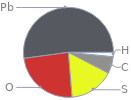Input interpretation

lead(II) methanesulfonate | elemental composition
Result

Find the elemental composition for lead(II) methanesulfonate in terms of the atom and mass percents: atom percent = N_i/N_atoms × 100% mass percent = (N_im_i)/m × 100% Plan: • Write the chemical formula and gather atomic masses from the periodic table. • Determine values for N_i, m_i, N_atoms and m using these items. • Finally, compute the percents and check the results. Write the chemical formula: Pb(CH_3SO_3)_2 Use the chemical formula, Pb(CH_3SO_3)_2, to count the number of atoms, N_i, for each element and find the total number of atoms, N_atoms: | number of atoms C (carbon) | 2 H (hydrogen) | 6 O (oxygen) | 6 Pb (lead) | 1 S (sulfur) | 2 N_atoms = 2 + 6 + 6 + 1 + 2 = 17 Divide each N_i by N_atoms to calculate atom fractions. Then use the property that atom fractions must sum to one to check the work: | number of atoms | atom fraction C (carbon) | 2 | 2/17 H (hydrogen) | 6 | 6/17 O (oxygen) | 6 | 6/17 Pb (lead) | 1 | 1/17 S (sulfur) | 2 | 2/17 Check: 2/17 + 6/17 + 6/17 + 1/17 + 2/17 = 1 Compute atom percents using the atom fractions: | number of atoms | atom percent C (carbon) | 2 | 2/17 × 100% = 11.8% H (hydrogen) | 6 | 6/17 × 100% = 35.3% O (oxygen) | 6 | 6/17 × 100% = 35.3% Pb (lead) | 1 | 1/17 × 100% = 5.88% S (sulfur) | 2 | 2/17 × 100% = 11.8% Look up the atomic mass, m_i, in unified atomic mass units, u, for each element in the periodic table: | number of atoms | atom percent | atomic mass/u C (carbon) | 2 | 11.8% | 12.011 H (hydrogen) | 6 | 35.3% | 1.008 O (oxygen) | 6 | 35.3% | 15.999 Pb (lead) | 1 | 5.88% | 207.2 S (sulfur) | 2 | 11.8% | 32.06 Multiply N_i by m_i to compute the mass for each element. Then sum those values to compute the molecular mass, m: | number of atoms | atom percent | atomic mass/u | mass/u C (carbon) | 2 | 11.8% | 12.011 | 2 × 12.011 = 24.022 H (hydrogen) | 6 | 35.3% | 1.008 | 6 × 1.008 = 6.048 O (oxygen) | 6 | 35.3% | 15.999 | 6 × 15.999 = 95.994 Pb (lead) | 1 | 5.88% | 207.2 | 1 × 207.2 = 207.2 S (sulfur) | 2 | 11.8% | 32.06 | 2 × 32.06 = 64.12 m = 24.022 u + 6.048 u + 95.994 u + 207.2 u + 64.12 u = 397.384 u Divide the mass for each element by m to calculate mass fractions. Then use the property that mass fractions must sum to one to check the work: | number of atoms | atom percent | mass fraction C (carbon) | 2 | 11.8% | 24.022/397.384 H (hydrogen) | 6 | 35.3% | 6.048/397.384 O (oxygen) | 6 | 35.3% | 95.994/397.384 Pb (lead) | 1 | 5.88% | 207.2/397.384 S (sulfur) | 2 | 11.8% | 64.12/397.384 Check: 24.022/397.384 + 6.048/397.384 + 95.994/397.384 + 207.2/397.384 + 64.12/397.384 = 1 Compute mass percents using the mass fractions: Answer: | | | number of atoms | atom percent | mass percent C (carbon) | 2 | 11.8% | 24.022/397.384 × 100% = 6.045% H (hydrogen) | 6 | 35.3% | 6.048/397.384 × 100% = 1.522% O (oxygen) | 6 | 35.3% | 95.994/397.384 × 100% = 24.16% Pb (lead) | 1 | 5.88% | 207.2/397.384 × 100% = 52.14% S (sulfur) | 2 | 11.8% | 64.12/397.384 × 100% = 16.14%
Mass fraction pie chart

Mass fraction pie chart